Li and Miao Villages
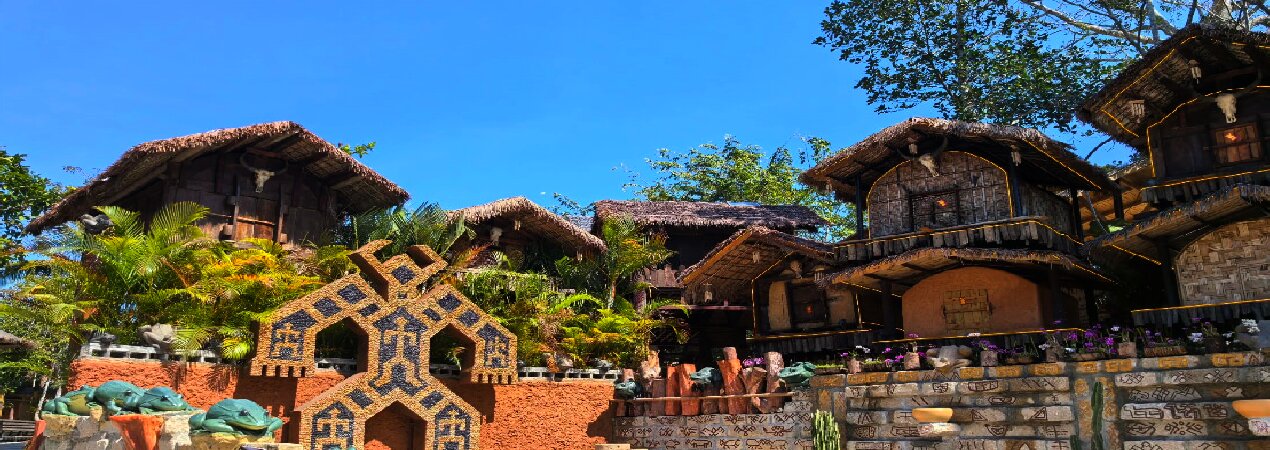
In Binlang Valley, two ethnic minorities, namely the Li ethnic group and the Hainan Miao ethnic group, reside. It serves as a demonstration base for the original ecology of the folk customs of the Li and Miao ethnic groups, and it is dedicated to the excavation and protection of the traditional culture of the indigenous people. The Li ethnic group is the only ancient indigenous ethnic group who live in compact communities on Hainan Island, with a history of more than 3,000 years.
The Binlang Valley Li and Miao Cultural Tourism Area showcases the life scenes and culture of Hainan's native Li and Miao ethnic groups. The scenic area consists of seven cultural experience areas: the Intangible Heritage Village, Ganshi Li Village, Rainforest Miao Village, Tianye Li Family, etc. In various theme exhibition halls within the scenic area, the most complete and precious collections of various folk cultural relics of the Li ethnic group across the entire Hainan Island are displayed, as well as all kinds of cultural relics and pictures that bear witness to the development process of the Li ethnic group. The simple and ecological villages truly showcase the production and living scenes of the indigenous people in Hainan.
- Chinese name: 黎村苗寨 Lí cūn Miáo zhài
- Suggested time: Half a day to a full day, depending on how in-depth you want to explore.
- Ticket: The ticket price may vary. Generally, it's around 80 - 120 yuan per person, but prices could be subject to change due to different seasons, promotions, or included packages.
- Open hours: Usually 8:00 - 17:30. However, it's advisable to check in advance as the opening hours might be adjusted during special holidays or for maintenance purposes.
- The best time to visit: All year around
- Address: Nanshan Village, Yazhou District, Sanya City, Hainan, China
- How to get there: You can take bus line 301 and get off at the relevant station near the cultural tourist area.
- Surroundings: Nanshan Temple, Thirty-three Guanyin Hall
Highlights of Li and Miao Villages
Intangible Cultural Heritage Projects
The Li and Miao villages showcase the intangible cultural heritages of the Li and Miao ethnic groups. You can witness the exquisite handicrafts on-site and even participate in hands-on experiences. The following are brief introductions to some Li ethnic group's intangible cultural heritage items, which will help you better understand them and feel the charm of traditional skills.
Li Ethnic Group's Clothing: It is mainly woven and stitched using island cotton, hemp, kapok, bark fibers, and silk. Generally, Li men wear front-buttoned, collarless jackets and long trousers. Women wear black round-necked, over-the-head dresses. When in full regalia, they insert silver hairpins in their hair, wear silver chains and necklaces around their necks, hang bead pendants on their chests, wear silver bracelets on their wrists, and tie black cloth headscarves.
Firewood - Jumping Dance: According to Li ethnic group's folklore, when building thatched huts, bamboo poles would keep sliding off the roof. To avoid getting their feet stabbed, people had to keep jumping. This amusing situation was gradually imitated and refined, giving rise to the "Firewood - Jumping Dance". The uniqueness of its props, rhythm, and dance steps, along with its high entertainment value, has made it a well-known dance of the Li ethnic group.
Bark Cloth: Bark cloth is regarded as the "ancestor of Li ethnic group's clothing". Before the use of hemp and kapok fibers, the ethnic minorities in ancient Hainan used tree bark as raw material. Through processes such as stripping and beating, they could make bark cloth, and the clothes made from it were very durable.
Construction Technique of Boat-shaped Houses:To commemorate their ancestors who crossed the sea, the Li people built houses in the shape of boats, which are commonly known as boat-shaped houses due to their resemblance to boat canopies. The circular arch design helps resist typhoons. The elevated structure prevents moisture, miasma, and rain, and the thatched roof has good moisture-proof and heat-insulating properties.
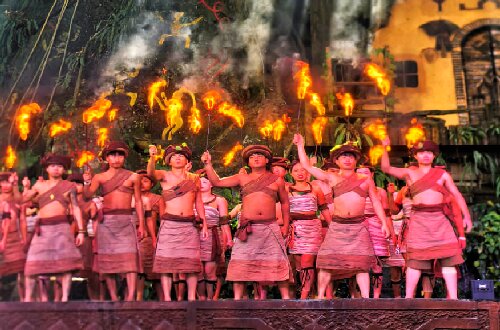 Firewood - Jumping Dance
Firewood - Jumping Dance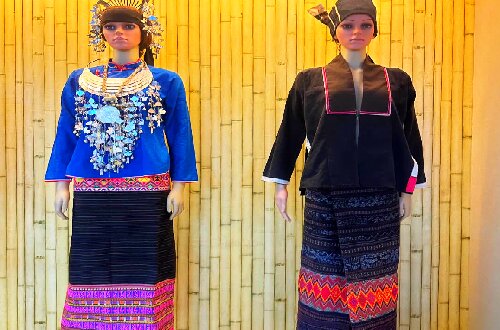 Li Ethnic Group's Clothing
Li Ethnic Group's ClothingIntangible Cultural Heritage Museum
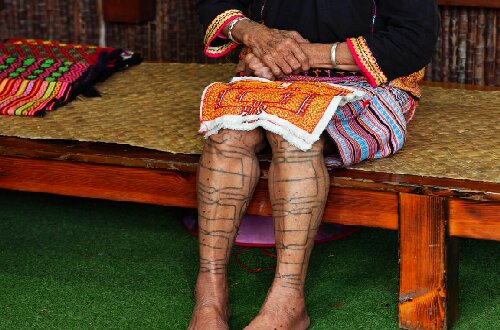 Tattooing
TattooingIn the Intangible Cultural Heritage Village, you can experience the four major theme museums of Hainan's indigenous people: the Non-woven Fabric Museum, the Hemp Textile Museum, the Cotton Textile Museum, and the Dragon Quilt Museum. Here, you can admire the great works of the Li ethnic group.
Dragon Quilt: It is a brocade handicraft with the greatest difficulty, the highest cultural taste, and the most superb technology among the four processes of spinning, weaving, dyeing, and embroidery. It is also one of the treasures that the Li ethnic group presented to the feudal dynasties in successive generations.
Hemp Textile Museum: It has collected various hemp textile products and production techniques of the Li people during the history of hemp textile. With a long history, it exudes a strong sense of the times.
Non-woven Fabric Museum: It displays the national intangible cultural heritage - the production technique of the Li ethnic group's bark cloth, as well as various precious products made of bark cloth. Bark cloth can prove the development process of human clothing from non-woven fabric to woven fabric.
Tattooing: It is an extremely ancient custom and an important personal adornment of the ancient Yue people in China and their descendants. It still exists among the Li ethnic group today. The tattoos of the Li ethnic group have important research value and serve as samples for the identification of ethnic groups, the study of human evolution, history, culture, and customs.
Totem Art Museum: The series of colored sculpture artworks collected in the Totem Art Museum are the fruit of several-year research on Li ethnic culture by Ms. Chen Yuxiang, a Hainanese folk artist. These artworks are made of a new type of environmentally friendly sculpture material (fiber-mixed clay) she developed. The colored sculpture artworks in the museum depict the local conditions and customs, totem worship, folk stories, and intangible cultural heritages of the Li ethnic group with unique shapes.
The Live Performance of Li and Miao Culture "Betel Nut · Ancient Charm"
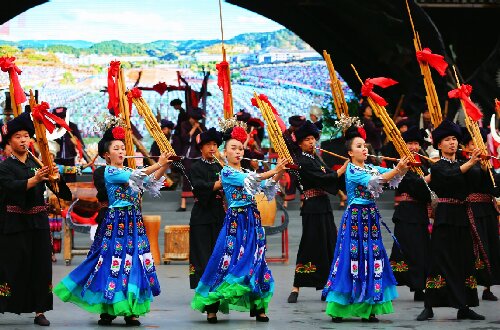 "Betel Nut · Ancient Charm"
"Betel Nut · Ancient Charm"The large-scale original ecological live performance of Li and Miao culture, "Betel Nut · Ancient Charm", is a visual feast that perfectly combines natural scenery and cultural performances. In the Binlang Valley Cultural Village, the song and dance drama "Betel Nut · Ancient Charm" is staged four times a day, and each show is extremely popular. The internationally renowned Firewood - Jumping Dance and Rice - Pounding Dance of the Li ethnic group vividly present the life of the Li people on this stage. Primitive methods like drilling wood to make fire, self-made Li ethnic musical instruments, and the world-class intangible cultural heritage-the Li brocade weaving technique, are also ingeniously integrated into the song and dance performances.
Educational Value
The cultural arts of the Li and Miao ethnic groups possess unique aesthetic values. From the exquisite patterns of Li brocade and the silver ornaments of the Miao ethnic group to the simple and unsophisticated architectural styles and the beautiful song and dance performances, all of these showcase the superb artistic attainments and distinctive aesthetic concepts of ethnic minorities. During the process of appreciating these artworks and cultural performances, you can enhance your own aesthetic level and cultivate the ability to appreciate beauty. In addition, the pattern designs of Li brocade, the embroidery techniques of the Miao ethnic group, and so on, can all serve as sources of inspiration for modern design, artistic creation, and other fields, stimulating your creativity and innovative thinking.
Activities to do at Li and Miao Villages
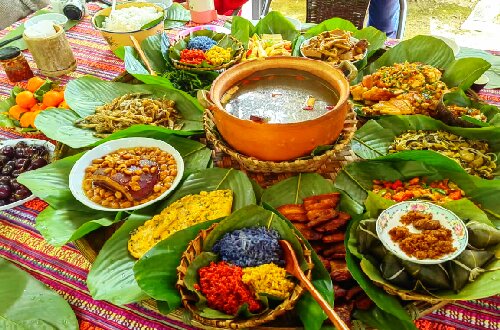 Specialty Delicacies
Specialty DelicaciesMaking of Specialty Delicacies: Participate in the long table banquet of the Miao ethnic group, savor the specialty delicacies, and you can also try your hand at making them, such as pounding glutinous rice cakes. Through this experience, you can feel the traditional craftsmanship of making delicacies, understand the characteristics of ingredients and cooking techniques, and enjoy the joy brought by delicious food.
Changing into Traditional Costumes: Put on the exquisite costumes of the Li and Miao ethnic groups and take photos as souvenirs. The front-buttoned collarless jackets and long trousers worn by Li men, the black round-necked garments that are pulled over the head worn by Li women, and the colorful costumes of the Miao ethnic group all have their own unique features.
Experiencing Folk Games: Participate in the bamboo pole dance of the Li ethnic group, feel the fun of teamwork and dancing, and enhance your understanding of ethnic customs amidst laughter and cheers.
Drop us a line and we'll connect you with the top China expert in no time!